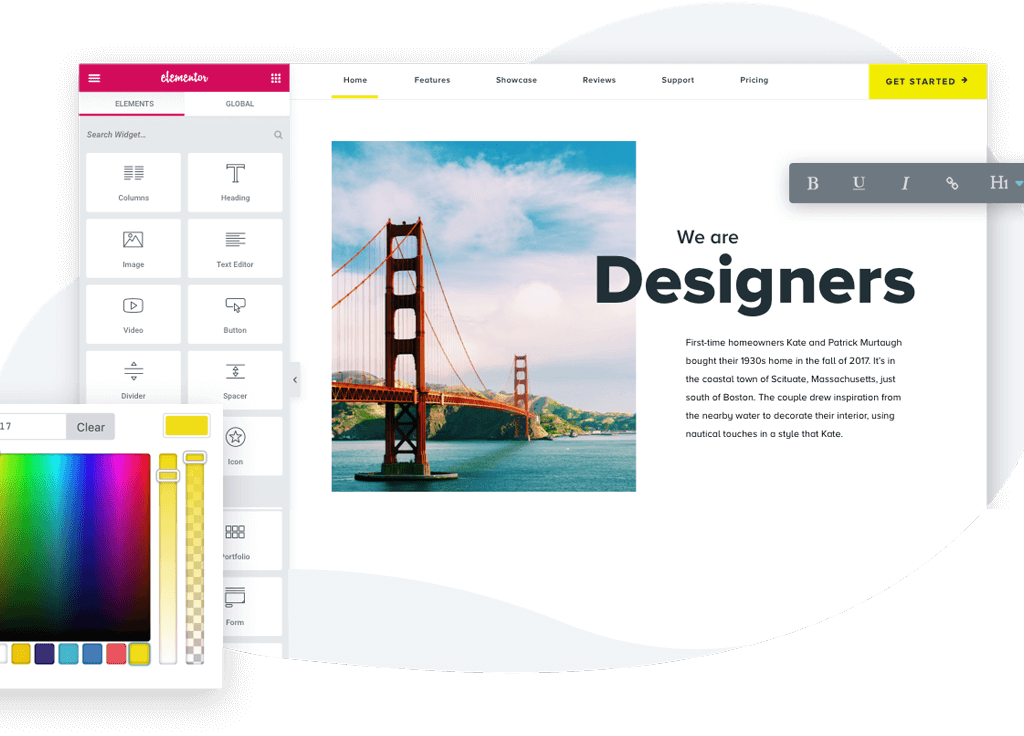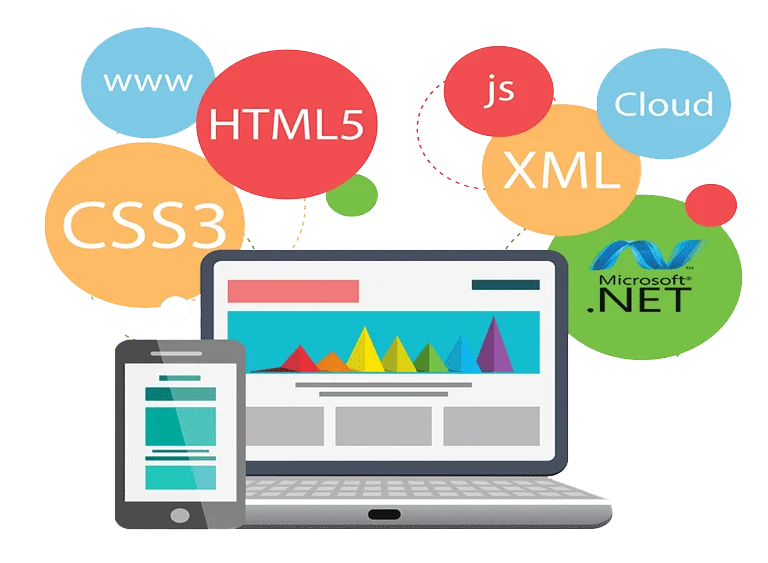Introduction:
In the digital age, the terms “web design web development” are often used interchangeably, leading to confusion about their distinct roles and responsibilities. However, these are two distinct disciplines “web design web development” that work collaboratively to create functional and visually appealing websites. In this blog post, we will delve into the key differences between web design web development, shedding light on the unique roles each plays in bringing websites to life for a better “web design web development”.
What is web design?
Web design is the process of creating the visual layout and user interface (UI) of a website. It encompasses various disciplines, including graphic design, user experience (UX) design, and user interface design, all aimed at crafting an engaging and visually appealing digital experience for website visitors.
Web design primarily focuses on the visual aspects of a website. It involves the creation of the website’s layout, user interface (UI), and user experience (UX). Web designers are responsible for crafting a visually engaging and intuitive interface that appeals to the target audience, as we look into the the responsibilities of a web designer that distinguishes the differences between “web design web development”.
Key Responsibilities of Web Designers:
- Visual Aesthetics: Web designers use colors, fonts, images, and other visual elements to create a cohesive and visually appealing design that aligns with the brand identity and message.

- User Experience (UX): Web designers optimize the website’s layout and navigation to ensure a smooth and intuitive user experience, making it easy for visitors to find the information they seek, Additionally, web designers often use a CMS such as WordPress, and a website builder platform like Elementor:

- Wireframing and Prototyping: Before starting the actual design, web designers create wireframes and interactive prototypes to visualize the website’s structure and functionality.
- Responsiveness: Web designers ensure that the website is responsive, adapting seamlessly to different devices and screen sizes.
- Branding and Visual Identity: Web designers are responsible for creating and maintaining a consistent branding and visual identity across the website. This includes designing logos, selecting color palettes, and choosing typography that aligns with the brand’s image.
- Graphic Design: Web designers use graphic design tools to create custom graphics, illustrations, icons, and other visual elements that enhance the overall aesthetics of the website and make it visually appealing.
- Accessibility and Inclusivity: Web designers consider accessibility guidelines and best practices to ensure that the website is inclusive and can be accessed by users with disabilities. They incorporate features like alt text for images and proper heading structures to improve usability for all users.
- Collaborating with Stakeholders: Web designers work closely with clients, project managers, content creators, and other stakeholders to understand their requirements, gather feedback, and ensure the final design aligns with the project’s objectives.
- Staying Updated with Design Trends: Web designers continuously research and keep abreast of the latest design trends, tools, and technologies to deliver modern and innovative website designs that resonate with the target audience.
What is Web development?
Web development refers to the process of building and maintaining websites and web applications. It involves a combination of technical skills, programming languages, and frameworks to create functional, interactive, and dynamic digital experiences that users can access through web browsers.
Web development, on the other hand, deals with the technical implementation and functionality of the website. Web developers use programming languages and frameworks to bring the web design to life and create interactive and dynamic web pages, as we look into the the responsibilities of a web developer that distinguishes the differences between “web design web development”.
Key Responsibilities of Web Developers:
- Front-End Development: Front-end developers work on the client-side of the website, translating the web design into code using HTML, CSS, and JavaScript. They are responsible for creating the visible elements and interactivity that users interact with directly.

- Back-End Development: Back-end developers focus on the server-side of the website, handling databases, servers, and the website’s logic. They develop the functionality that enables dynamic content generation and data processing.
- Content Management Systems (CMS): Web developers may work with CMS platforms like WordPress, Drupal, or Joomla, customizing and extending their functionalities to meet the specific needs of the website.
- Testing and Debugging: Web developers conduct rigorous testing to ensure the website’s functionality and performance, resolving any bugs or issues that may arise.
- Database Management: Web developers design and manage databases that store website content, user data, and other information. They ensure efficient data retrieval and manipulation for dynamic web pages.
- Security Implementation: Web developers prioritize website security by implementing secure coding practices, handling user authentication, and protecting against potential vulnerabilities like SQL injection and cross-site scripting (XSS) attacks.
- Website Optimization: Web developers focus on optimizing the website’s performance by reducing loading times, minimizing server requests, and implementing caching mechanisms to enhance the user experience.
- Version Control and Collaboration: Web developers use version control systems like Git to track changes in the codebase and collaborate effectively with other team members. This ensures a smooth workflow and easy integration of new features.
- Troubleshooting and Debugging: Web developers are responsible for identifying and resolving technical issues that may arise during website development and deployment. They conduct thorough testing and debugging to ensure the website functions flawlessly across different browsers and devices.
Similarities between web design web development
Web design and web development are closely related fields that work in tandem to create and maintain websites. While they have distinct roles, they also share some common elements:
- Collaboration: Web designers and web developers often collaborate closely during the website creation process. Effective communication between the two is crucial to ensure that the final product aligns with the design and functionality goals.
- User-Centric Approach: Both fields prioritize the user experience. Web designers aim to create visually appealing and user-friendly interfaces, while web developers ensure smooth functionality and interactivity to enhance user engagement.
- Responsive Design: Both web designers and developers need to consider responsive design, ensuring that websites function and look well across various devices and screen sizes.
- Technology Trends: Both fields stay updated with the latest technology trends. Designers incorporate modern design styles and aesthetics, while developers adopt new programming languages, frameworks, and tools to enhance website performance and functionality.
- UI/UX: While web designers focus more on UI (user interface) design and web developers on back-end functionality, both consider UX (user experience) to ensure a seamless and enjoyable interaction for users.
- Coding Basics: While web developers delve deeper into coding, web designers often have a basic understanding of HTML and CSS to implement their designs or communicate effectively with developers.
- Problem-Solving: Both roles require problem-solving skills. Designers address layout and visual challenges, while developers troubleshoot technical issues and optimize website performance.
- Content Integration: Both designers and developers work together to integrate content seamlessly into the website. Designers ensure content is presented in an aesthetically pleasing manner, while developers make sure it’s accessible and functional.
- Continuous Learning: The digital landscape evolves rapidly. Both designers and developers need to stay updated with industry changes, new design trends, programming languages, and tools.
- Project Lifecycle: Both roles are involved in different stages of the project lifecycle, from planning and designing to development, testing, and deployment.
In essence, web design and web development complement each other, with both contributing essential elements to create a successful and well-functioning website
Conclusion:
In conclusion, “web design web development” are two distinct disciplines that collaborate to create exceptional websites. Web design is all about the visual aesthetics and user experience, while web development focuses on turning those designs into functional, interactive, and dynamic web pages. Both play crucial roles in the website creation process, complementing each other’s strengths to produce a seamless and captivating online presence.
Understanding “web design web development” differences is essential for building successful websites. When hiring professionals or building a team for your website project, it’s crucial to have a clear understanding of the specific skills required for each role in “web design web development”. By appreciating the unique contributions of both web designers and web developers, you can ensure the successful realization of your website’s vision and create an exceptional digital experience for your users. The synergy between web designers and web developers is more than just a division of labor in “web design web development”; it is a collaborative effort that drives innovation and excellence in website creation. In “web design web development”, both disciplines constantly evolve to adapt to changing technologies and user preferences, contributing to the ever-improving landscape of the web.
